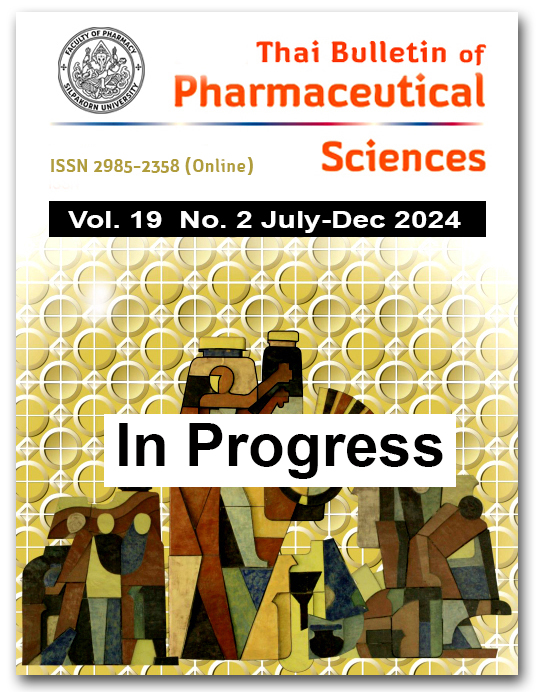กลไกภาวะเครียดที่เกิดจากออกซิเดชันในโรคไตเรื้อรัง
DOI:
https://doi.org/10.69598/tbps.19.2.211-220คำสำคัญ:
ภาวะเครียดที่เกิดจากออกซิเดชัน, อนุมูลอิสระ, โรคไตเรื้อรังบทคัดย่อ
โรคไตเรื้อรัง (Chronic kidney disease, CKD) เป็นปัญหาสุขภาพที่สำคัญซึ่งเกิดจากการทำลายของไตและท่อไต CKD มีลักษณะเฉพาะคือมีอัตราการกรองที่ไตลดลงและเกิดภาวะปัสสาวะมีโปรตีน (proteinuria) ตามมา งานวิจัยในช่วงที่ผ่านมาชี้ให้เห็นว่า ภาวะเครียดที่เกิดจากออกซิเดชัน (oxidative stress) มีบทบาทสำคัญในการทำให้เกิดพยาธิสภาพของโรคไตเรื้อรัง โดยในกระบวนการพัฒนาไปเป็นโรคไตเรื้อรังนั้นพบมีการสร้างอนุมูลอิสระทั้งชนิด reactive oxygen species (ROS) และ reactive nitrogen species (RNS) ที่มากเกินไปจนเกินความสามารถของระบบต้านอนุมูลอิสระของร่างกายที่จะสามารถกำจัดอนุมูลอิสระได้หมด ทำให้เกิดการทำลายโมเลกุลเป้าหมาย เช่น DNA โปรตีน และไขมัน ส่งผลให้เกิดการตายของเซลล์ มีหลักฐานแสดงให้เห็นว่า ภาวะเครียดที่เกิดจากออกซิเดชันนั้นสัมพันธ์กับการเกิด CKD และมีส่วนทำให้โรคไตแย่ลงผ่านกลไกหลายประการ ได้แก่ (1) การทำงานผิดปกติของไมโตคอนเดรียที่ทำให้เกิดการผลิต ROS เพิ่มขึ้น (2) การกระตุ้นของการทำงานของเอนไซม์ NADPH-Oxidase (NOX) isoforms ซึ่งเป็นแหล่งสำคัญของภาวะเครียดที่เกิดจากออกซิเดชันในไต (3) การแยกตัวของเอนไซม์ eNOS ซึ่งเป็นปัจจัยสำคัญที่ทำให้เกิดความเครียดจากออกซิเดชันและความเสียหายต่อไต (4) เอนไซม์ Myeloperoxidase (MPO) ซึ่งมีบทบาทในการพัฒนาและการแย่ลงของโรคไต (5) การทำงานของเอนไซม์ xanthine oxidase (XO) ที่เพิ่มขึ้นในผู้ป่วย CKD (6) การมีระดับเอนไซม์ superoxide dismutase-1 ที่สูงขึ้นในผู้ป่วยที่ได้รับการฟอกเลือด และ (7) การมีปัจจัยส่งเสริมการอักเสบใน CKD ที่ไปเพิ่มภาวะเครียดที่เกิดจากออกซิเดชันและรบกวนสมดุลเรด็อกซ์ ภาวะเครียดที่เกิดจากออกซิเดชันและการอักเสบนี้นำไปสู่การบาดเจ็บของเนื้อเยื่อ การแย่ลงของโรค และความรุนแรงของ CKD ในปัจจุบันมีการนำยาและสารต้านอนุมูลอิสระมาใช้เพื่อรับมือกับภาวะเครียดที่เกิดจากออกซิเดชันและเพื่อบรรเทาอาการทางคลินิก โดยมีวัตถุประสงค์เพื่อชะลอการแย่ลงของโรคและลดผลกระทบทางคลินิกที่เกิดจาก CKD
เอกสารอ้างอิง
Piko N, Bevc S, Hojs R, Ekart R. The role of oxidative stress in kidney injury. Antioxidants (Basel). 2023;12(9):1772.
Vida C, Oliva C, Yuste C, Ceprian N, Caro PJ, Valera G, et al. Oxidative stress in patients with advanced CKD and renal replacement therapy: The key role of peripheral blood leukocytes. Antioxidants. 2021;10(7):1155.
Rapa SF, Iorio BRD, Campiglia P, Heidland A., Marzocco S. Inflammation and oxidative stress in chronic kidney disease-Potential therapeutic role of minerals, vitamins and plant-derived metabolites. Int J Mol Sci. 2020;21(1):263.
Gyuraszova M, Gurecka R, Babickova J, Tothova L. Oxidative stress in the pathophysiology of kidney disease: Implications for noninvasive monitoring and identification of biomarkers. Oxid Med Cell Longev. 2020:5478708.
Podkowinska A, Formanowicz D. Chronic kidney disease as oxidative stress- and inflammatory-mediated cardiovascular disease. Antioxidants. 2020;9(8):752.
Verma S, Singh P, Khurana S, Ganguly NK, Kukreti R, Saso L. Implications of oxidative stress in chronic kidney disease: A review on current concepts and therapies. Kidney Res Clin Pract. 2021;40(2):183-93.
Pongnimitprasert N. The role of ROS in atherosclerosis and antioxidant. Thai Bull Pharm Sci. 2023;18(2):69-79. (in Thai)
Liguori I, Russo G, Curcio F, Bulli G, Aran L, Della-Morte D, et al. Oxidative stress, aging, and diseases. Clin Interv Aging. 2018;13:757-72.
Leyane TS, Jere SW, Houreld NN. Oxidative stress in ageing and chronic degenerative pathologies: Molecular mechanisms involved in counteracting oxidative stress and chronic inflammation. Int J Mol Sci. 2022;23(13):7273.
Casciaro M, Salvo ED, Pace E, Ventura-Spagnolo E, Navarra M, Gangemi S. Chlorinative stress in age-related disease: A literature review. Immun aging. 2017;14(21):1045.
Adly AAM. Oxidative stress and disease: An updated review. Res J Immunol. 2010;3(2):129-45.
Matei D, Buculei I, Luca C, Corciova C-P, Andritoi D, Fuior R, et al. Impact of non-pharmacological interventions on the mechanisms of atherosclerosis. Int J Mol Sci. 2022;23(16):9097.
Meziri F, Brahimi FZ, Dorbane C. Modulation of oxidative stress in chronic kidney disease patients with different physiopathological conditions. J Complement Med Res. 2022;13(2):29-33.
Gyuraszova M, Kovalcikova AG, Renczes E, Kmet’ova K, Celec P, Babickova J, et al. Oxidative stress in animal models of acute and chronic renal failure. Dis Markers. 2019:8690805.
Thana M, Kadariswantiningsih IN, Empitu MA. Association of high blood pressure with elevated oxidative stress, inflammatory marker and albuminuria in chronic kidney disease patients. J Med. 2019:20(1):12-8.
Kuchta A, Pacanis A, Kortas-Stempak B, Cwiklinska A, Zietkiewicz M, Renke M, et al. Estimation of oxidative stress markers in chronic kidney disease. Kidney Blood Press Res. 2011;34(1):12-9.
Stenvinkel P, Carrero JJ, Axelsson J, Lindholm B, Heimbürger O, Massy Z. Emerging biomarkers for evaluating cardiovascular risk in the chronic kidney disease patient: How do new pieces fit into the uremic puzzle? Clin J Am Soc Nephrol. 2008;3(2):505-21.
Daenen K, Andries A, Mekahli D, Schepdael AV, Jouret F, Bammens B. Oxidative stress in chronic kidney disease. Pediatr Nephrol. 2019;34(6):975-91.
Tirichen H, Yaigoub H, Xu W, Wu C, Li R, Li Y. Mitochondrial Reactive Oxygen Species and Their Contribution in Chronic Kidney Disease Progression Through Oxidative Stress. Front Physiol. 2021;12:627837.
Kellum JA, Romagnani P, Ashuntantang G, Ronco C, Zarbock A, Anders H-J. Acute kidney injury. Nat Rev Dis Primers. 2021;7(1):52.
Dobrek T. Oxidative stress mechanisms as potential therapeutic targets in chronic kidney disease. Med Stud/Studia Medyczne. 2022;38(20):163-70.
Tanakitjaru P, Boonnak S, Pchaiwong W. Chronic kidney disease: CKD. 1st ed. [internet]. 2023 [cite 2023 Aug 2]. Available from: https://www.nephrothai.org/wp-content/uploads/2022/11/%E0%B9%82%E0%B8%A3%E0%B8%84%E0%B9%84%E0%B8%95%E0%B9%80%E0%B8%A3%E0%B8%B7%E0%B9%89%E0%B8%AD%E0%B8%A3%E0%B8%B1%E0%B8%87.pdf (in Thai)
Granata S, Zaza G, Simone S, Villani G, Latorre D, Pontrelli P, et al. Mitochondrial dysregulation and oxidative stress in patients with chronic kidney disease. BMC Genomics. 2009;10(1):388.
Galvan DL, Green NH, Danesh FR. The hallmarks of mitochondrial dysfunction in chronic kidney disease. Kidney Int. 2017;92(5):1051-7.
Correa S, Korina Pena-Esparragoza J, Scovner KM, Waikar SS, Mc Causland FR. Myeloperoxidase and the risk of CKD progression, cardiovascular disease, and death in the Chronic Renal Insufficiency Cohort (CRIC) Study. Am J Kidney Dis. 2020;76(1):32-41.
Kohagura K, Tana T, Higa A, Yamazato M, Ishida A, Nagahama K. Effects of xanthine oxidase inhibitors on renal function and blood pressure in hypertensive patients with hyperuricemia. Hypertens Res. 2016;39(8):593-7.
Jha JC, Gray SP, Barit D, Jun O, Assam El-O, Tamehachi N, et al. Genetic targeting or pharmacologic inhibition of NADPH oxidase nox4 provides renoprotection in long-term diabetic nephropathy. J Am Soc Nephrol. 2014:25(6):1237-54.
Gorin Y, Cavaglieri RC, Khazim K, Lee D-Y, Bruno F, Thakur S, et al. Targeting NADPH oxidase with a novel dual Nox1/Nox4 inhibitor attenuates renal pathology in type 1 diabetes. Am J Physiol Renal Physiol. 2015;308(11):F1276-87.
Ling XC, Kuo K-L. Oxidative stress in chronic kidney disease. Ren Replace Ther. 2018;4(53):1952.
Ivanovski O, Szumilak D, Nguyen-Khoa T, Ruellan N, Phan O, Lacour B, et al. The antioxidant N-acetylcysteine prevents accelerated atherosclerosis in uremic apolipoprotein E knockout mice. Kidney Int. 2005;67(6):2288-94.



